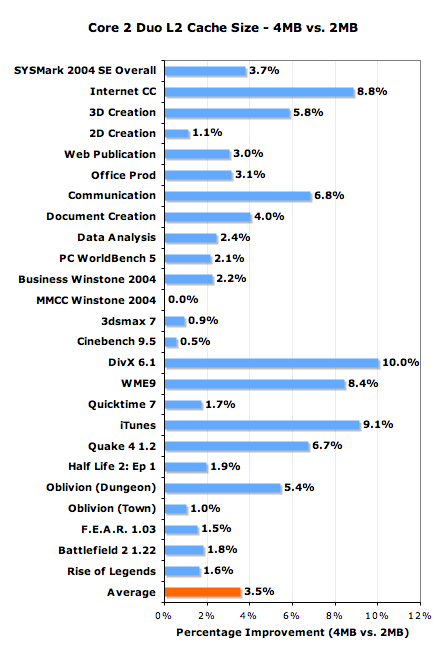Intel's Core 2 Extreme & Core 2 Duo: The Empire Strikes Back
by Anand Lal Shimpi on July 14, 2006 12:00 AM EST- Posted in
- CPUs
L2 Cache: 4MB or 2MB?
The majority of Intel's Core 2 Duo line feature a single shared 4MB L2 cache, but the E6300 and E6400 are only equipped with a 2MB cache. Given that the Core 2 Duo doesn't have an on-die memory controller, it is more dependent on larger caches than AMD's Athlon 64 X2, which raises the question - how big of a difference is there between the 2MB L2 and 4MB L2 parts?
Our Core 2 Extreme X6800 (2.93GHz) part, like all X6800s, is unlocked so we could simulate any other Core 2 Duo clock speed with it. We managed to get our hands on a Core 2 Duo E6300 (1.86GHz/2MB) and we were in business.
The graph below features all of the benchmarks we ran on the processors in this review, showing the percent performance improvement from a Core 2 Duo E6300 (1.86GHz/2MB) to a hypothetical 1.86GHz Core 2 Duo with a 4MB L2 cache. The bar labeled "Average" is simply an average of all of the performance improvements graphed on the chart.

The 4MB L2 cache can increase performance by as much as 10% in some situations. Such a performance improvement is definitely tangible, and as applications grow larger in their working data sets then the advantage of a larger cache will only become more visible. Unfortunately, you do pay a price premium for this added performance and future proofing as the cheapest 4MB L2 part is the E6600 priced at $316.
If you're the type to upgrade often, then the extra cache is not worth it as you're not getting enough of a present day increase in performance to justify the added cost. However, if this processor will be the basis for your system for the next several years, we'd strongly recommend picking a 4MB flavor of Core 2.










202 Comments
View All Comments
MrKaz - Friday, July 14, 2006 - link
So how do you calculate performance/watt?Based on Doom3? Quake4? Lame? PowerDVD? Divx encoding?
My point is, this is "impossible" to do, unless you do it for all progs and games.
Picking up just one of them is being biased...
JarredWalton - Friday, July 14, 2006 - link
Including performance/watt on *ANY* game is a bit odd, given that the GPU will comsume more power than the CPU. That's why when we talk about performance per watt on GPUs, we use the same platform for all tested systems.If we're going to talk about performance per watt and we're worried about the CPU and platform, then we should look at benchmarks that stress that portion of the system more than anything else. In fact, you could argue that we should drop down to the lowest power GPU possible, or even go with an integrated graphics solution. Anyway, here are a few of the results using WME9:
0.358 FPS/W X6800
0.319 FPS/W E6600
0.279 FPS/W 4600+ EE
0.276 FPS/W 3800+ EE
0.273 FPS/W 5000+
0.244 FPS/W FX-62
0.244 FPS/W E6300
0.228 FPS/W PD XE 965
Part of the reasons on the lower performance Core 2 Duo chips score so poorly is because we are measuring Watts of the entire system. It's reasonable to say that the motherboard, hard drives, graphics card, etc. probably use up on average 100 W of power, give or take. The AMD motherboard and peripherals might also use a bit less power than than the Intel board, or vice versa, so the 12 W difference in power draw at idle shouldn't be considered really significant.
What is significant is that other than the two energy efficient AMD chips (which you can't yet purchase on the retail market), Core 2 offers better performance per watt at similar price points. We could go and measure performance per watt on a bunch of the other applications (even games, though the differences are going to be greatly diminished given the GPUs requirements), but the results really aren't likely to change much. Core 2 is faster than AMD, and at worst it matches AMD's power requirements; ergo Core 2 offers better performance for watt.
epsilonparadox - Friday, July 14, 2006 - link
Intel didn't start the focus on performance by watt. AMD started it and ruled the charts based on that measure. Every single X2 vs P4D review has a chart for that measurement. Intel w/ the C2D just turned the table back on them by harping on the same issue. If this measurement didn't become a big deal, you'd likely be running dual 1000W psus to run dual core/multi gpu setups.Furen - Friday, July 14, 2006 - link
It's hard to do a performance/watt chart because processors perform differently under different applications. I'm sure you'll agree with the fact that the E6600 is much faster than an X2 3800+ yet draws only slightly more power.bupkus - Friday, July 14, 2006 - link
: (Where's the pics?
My browser doesn't show them on the first page.
Gary Key - Friday, July 14, 2006 - link
What browser?bupkus - Friday, July 14, 2006 - link
FirefoxGary Key - Friday, July 14, 2006 - link
I have tried three different versions of FireFox on varying machines without an issue so far. Still looking in to it.JarredWalton - Friday, July 14, 2006 - link
Options ->Web features ->
Load Images ->
UNCHECK "for the originating web site only"
ianwhthse - Friday, July 14, 2006 - link
Mine is already unchecked, however I cannot see the pictures either. [Firefox]Kicking and screaming, which is somewhat disruptive @4am, I opened Internet Explorer and I cannot see the images there, either.